instrument panel OLDSMOBILE BRAVADA 1998 Owners Manual
[x] Cancel search | Manufacturer: OLDSMOBILE, Model Year: 1998, Model line: BRAVADA, Model: OLDSMOBILE BRAVADA 1998Pages: 380, PDF Size: 19.2 MB
Page 23 of 380
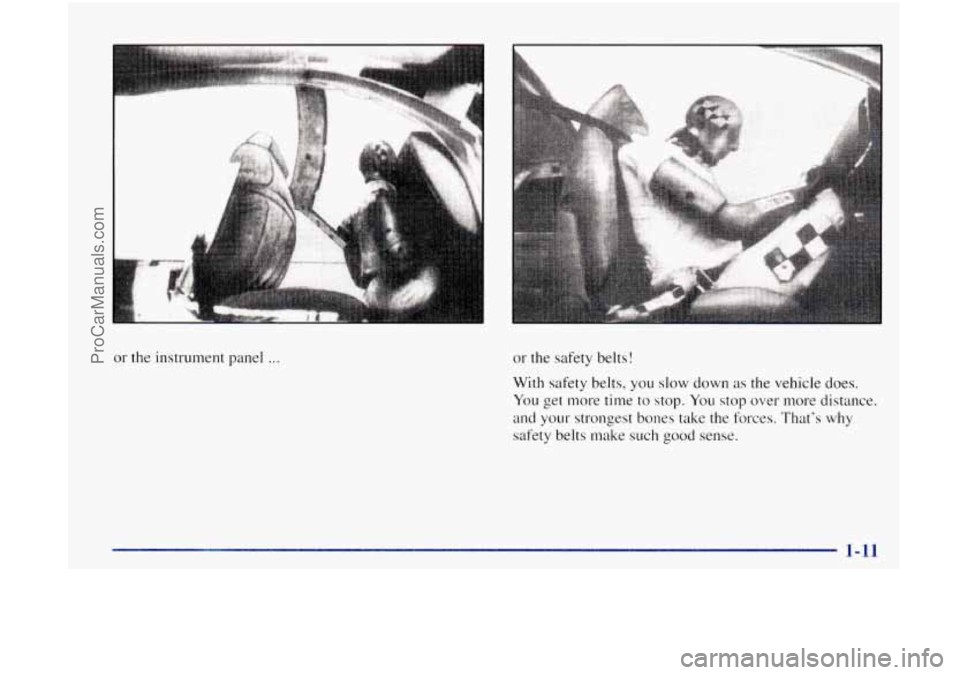
or the instrument panel ... or the safety belts!
With safety belts, you slow down
as the vehicle does.
You get more time to stop. You stop over more distance.
and your strongest bones take the forces. That’s why
safety belts make such
good sense.
1-11
ProCarManuals.com
Page 33 of 380
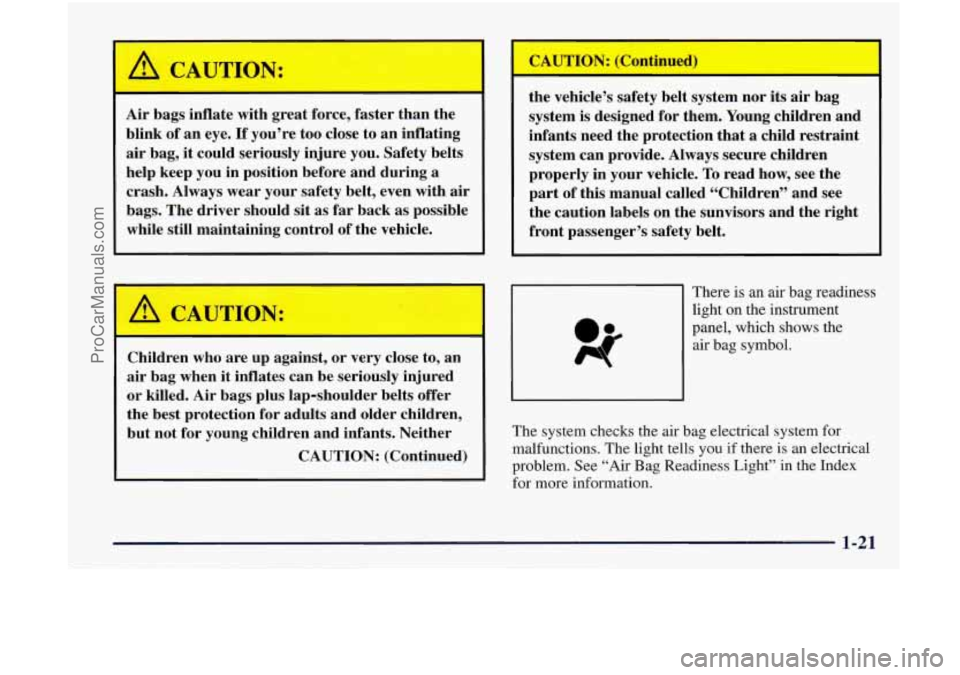
A CAUTION:
Air bags inflate with great force, faster than the
blink of an eye.
If you’re too close to an inflating
air bag, it could seriously injure you. Safety belts
help keep you in position before and during a
crash. Always wear your safety belt, even with air
bags. The driver should sit as
far back as possible
while still maintaining control of the vehicle.
/! CAUTION:
Children who are up against, or very close to, an
air bag when it inflates can be seriously injured
or killed.
Air bags plus lap-shoulder belts offer
the best protection for adults and older children,
but not for young children and infants. Neither
CAUTION: (Continued) the
vehicle’s safety belt system nor
its air bag
system
is designed for them. Young children and
infants need the protection that
a child restraint
system can provide. Always secure children
properly in your vehicle. To read how, see the
part of this manual called “Children” and see
the caution labels
on the sunvisors and the right
front passenger’s safety belt.
There is an air bag readiness
light on the instrument
panel, which shows the
air bag symbol.
The system checks the air bag electrical system for
malfunctions. The light tells
you if there is an electrical
problem. See “Air Bag Readiness Light” in the Index
for more information.
1-21
ProCarManuals.com
Page 34 of 380

How the Air Bag System Works
Where are the air bags?
The driver’s air bag is in the middle of the steering wheel. The
right front passenger’s air bag is in the instrument
panel on the passenger’s side.
1-22
ProCarManuals.com
Page 36 of 380
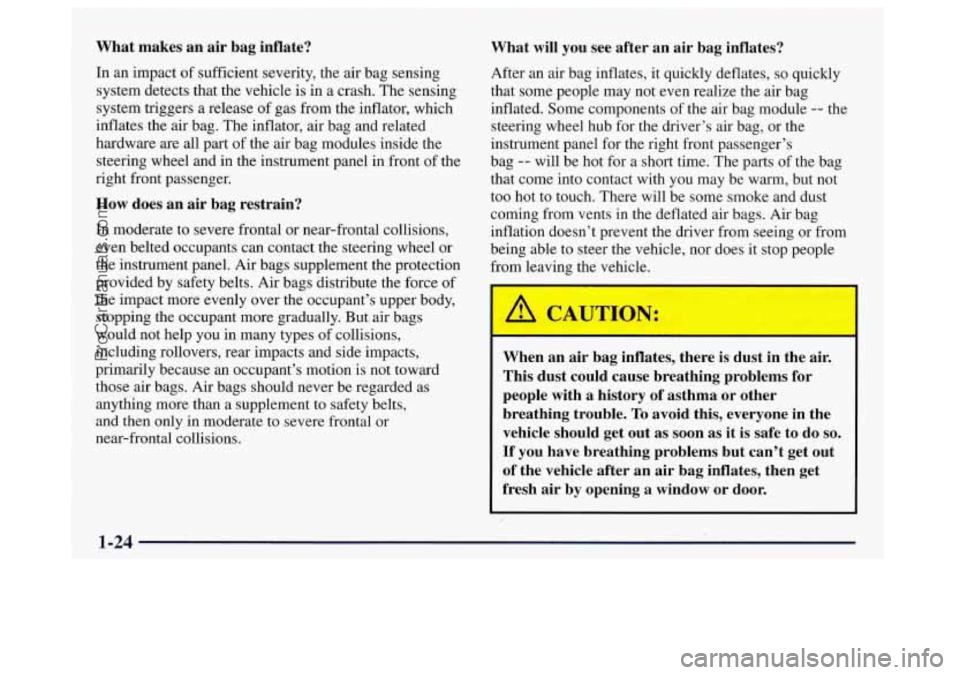
What makes an air bag inflate?
In an impact of sufficient severity, the air bag sensing
system detects that the vehicle is in a crash. The sensing
system triggers a release of gas from the inflator, which
inflates the air bag. The inflator, air bag and related
hardware are all part of the air bag modules inside the
steering wheel and in the instrument panel in front of the
right front passenger.
How does an air bag restrain?
In moderate to severe frontal or near-frontal collisions,
even belted occupants can contact the steering wheel or
the instrument panel. Air bags supplement the protection
provided by safety belts. Air bags distribute the force of
the impact more evenly over the occupant's upper body,
stopping the occupant more gradually. But air bags
would not help you in many types of collisions,
including rollovers, rear impacts and side impacts,
primarily because an occupant's motion is not toward
those air bags. Air bags should never be regarded as
anything more than a supplement to safety belts,
and then only in moderate to severe frontal
or
near-frontal collisions.
What will you see after an air bag inflates?
After an air bag inflates, it quickly deflates, so quickly
that some people may not even realize the air bag
inflated. Some components of the air bag module
-- the
steering wheel hub for the driver's air bag, or the
instrument panel for the right front passenger's
bag
-- will be hot for a short time. The parts of the bag
that come into contact with you may be warm, but not
too hot to touch. There will be some smoke and dust
coming from vents in the deflated air bags. Air bag
inflation doesn't prevent the driver from seeing or from
being able to steer the vehicle, nor does it stop people
from leaving the vehicle.
When an air bag inflates, there is dust in the air.
This dust could cause breathing problems for
people with a history of asthma or other
breathing trouble.
To avoid this, everyone in the
vehicle should get out as soon as it is safe
to do so.
If you have breathing problems but can't get out
of the vehicle after an air bag inflates, then get
fresh air by opening a window or door.
ProCarManuals.com
Page 37 of 380
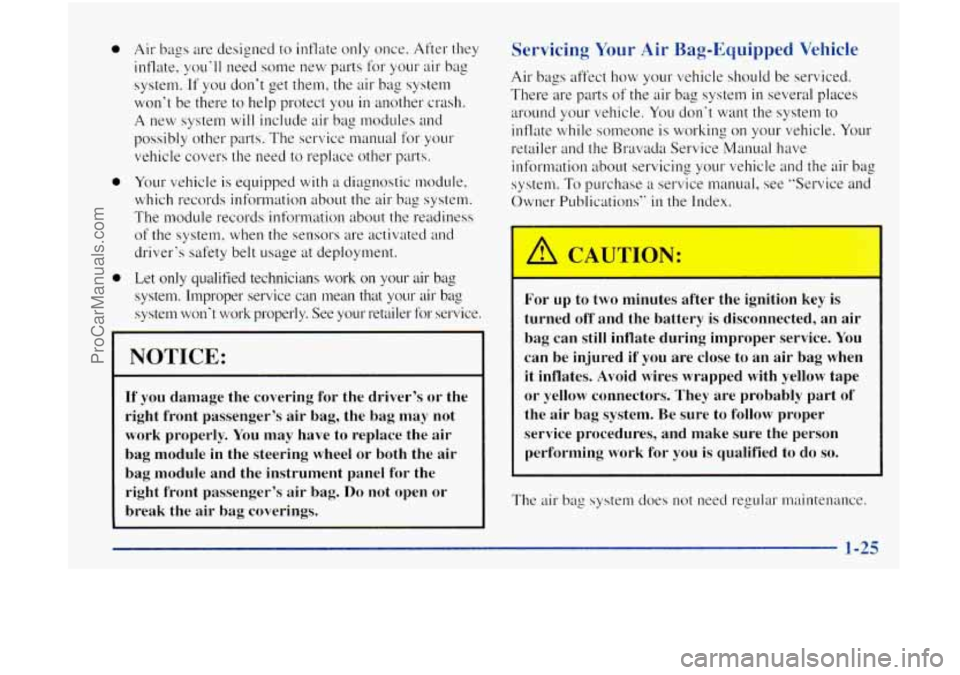
0 Air bags are designed to inflate only once. After they
inflate, you‘ll need some new parts for your air bag
system.
If you don’t get them, the air bag system
won’t be there to help protect you
in another crash.
A new system will include air bag modules and
possibly other parts. The service manual for your
vehicle covers the need to replace other parts.
0 Your vehicle is equipped with a diagnostic module,
which records information about the air bag system.
The module records information about the readiness
of the system, when the sensors
are activated and
driver’s safety belt usage at deployment.
0 Let only qualified technicians work on your air bag
system. Improper service can mean that your air bag
system won’t work properly. See your retailer for service.
NOTICE:
If you damage the covering for the driver’s or the
right front passenger’s air bag, the bag may not
work properly. You may have to replace the air
bag module in the steering wheel or both the
air
bag module and the instrument panel for the
right front passenger’s air bag.
Do not open or
break the air bag coverings.
Servicing Your Air Bag-Equipped Vehicle
Air bags affect how your vehicle should be serviced.
There are parts of the air bag system in several places
around your vehicle.
You don‘t want the system to
inflate while someone is working on your vehicle. Your
retailer and the Bravada Service Manual have
information about servicing your vehicle and the air bag
system. To purchase a service manual, see “Service and
Owner Publications”
in the Index.
For up to two minutes after the ignition key is
turned off and the battery is disconnected, an air
bag can still inflate during improper service. You
can be injured if you are close to
an air bag when
it inflates. Avoid wires wrapped with yellow tape
or yellow connectors. They are probably part
of
the air bag system. Be sure to follow proper
service procedures, and make sure the person
performing work for you is qualified to do
so.
The air bag system does not need regular maintenance.
ProCarManuals.com
Page 65 of 380
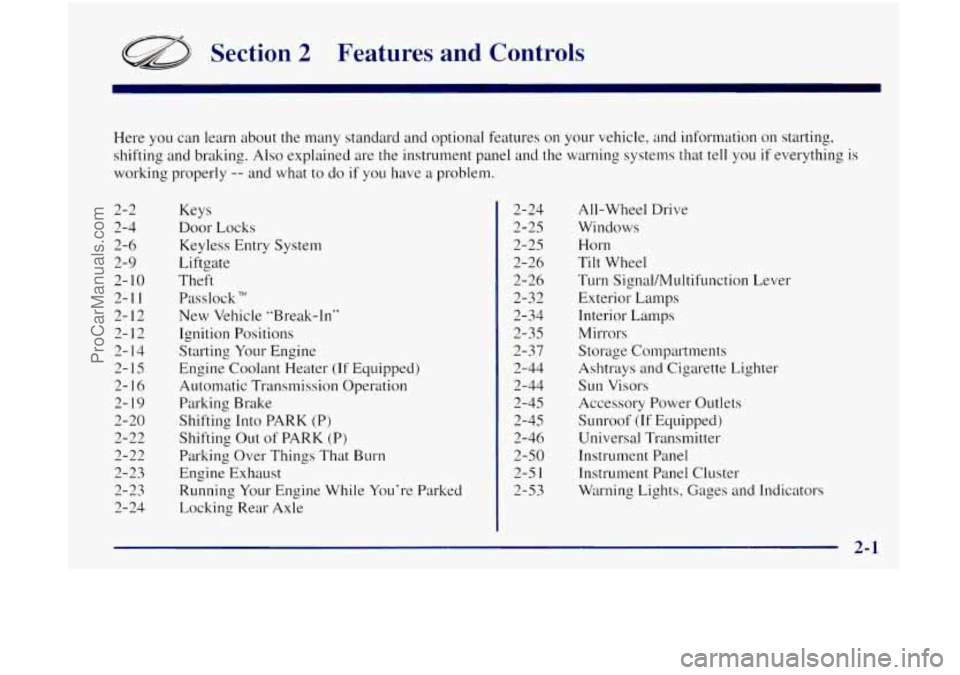
a Section 2 Features and Controls
Here you can learn about the many standard and optional features on your vehicle, and information on starting,
shifting and braking. Also explained are
the instrument panel and the warning systems that tell you if everything is
working properly
-- and what to do if you have a problem.
2-2
2-4
2-6
2-9
2-
10
2-1 1
2- 12 2- 12
2- 14
2- 15
2-16
2- 19
2-20
2-22
2-22
2-23
2-23
2- 24 Keys
Door Locks
Keyless Entry System
Liftgate
Theft Passlock
TM
New Vehicle “Break-In”
Ignition Positions
Starting Your Engine
Engine Coolant Heater
(If Equipped)
Automatic Transmission Operation
Parking Brake
Shifting Into PARK
(P)
Shifting Out of PARK (P)
Parking Over Things That Burn
Engine Exhaust
Running Your Engine While You’re Parked
Locking Rear Axle 2-24
2-25
2-25
2-26
2-26
2-32 2-34
2-35
2-37 2-44
2-44
2-45
2-45 2-46
2-50
2-5
1
2-53 All-Wheel Drive
Windows Horn
Tilt Wheel
Turn Signal/Multifunction Lever
Exterior Lamps
Interior Lamps
Mirrors
Storage Compartments Ashtrays and Cigarette Lighter
Sun Visors
Accessory Power Outlets
Sunroof (If Equipped)
Universal Transmitter Instrument Panel
Instrument Panel Cluster
Warning Lights, Gages and Indicators
ProCarManuals.com
Page 73 of 380

Liftgate
It can be dangerous to drive with the rear
window or liftgate open because carbon
monoxide (CO) gas can come into your vehicle.
You can’t see or snlell CO. It can cause
unconsciousness and even death.
If you must drive with the rear window or liftgate
open or if electrical wiring or other cable
connections must pass through the seal between
the body and the rear window or liftgate:
0 Make sure all windows are shut.
0 Turn the fan on your heating or coaling
system to its highest speed with the setting
on
VENT. That will force outside air into
your vehicle. See “Comfort Controls” in
the Index.
instrument panel, open them all the
way.
If you have air outlets on or under the
See “Engine Exhaust” in the Index.
Liftgate Release
There are several ways to release the liftgate. However,
the liftgate
will not release if the vehicle is in gear.
You can use your key
to unlock the liftgate from the
outside. Insert the key into
the liftgate lock button and
turn
it to the left. All doors will unlock.
You may
also use the Keyless Entry System
described earlier.
The liftgate can be opened without
a key if the driver’s
door
is unlocked.
To open the liftgate glass
only, ~~nlock the liftgate
and press the button.
To open the entire liftgate, unlock the liftgate and lift the
handle located
in the center of the door.
2-9
ProCarManuals.com
Page 83 of 380

Parking Brake
To set the parking brake, hold the regular brake pedal
down
with your right foot. Push down the parking brake
pedal with your left foot.
If the ignition is on, the brake
system warning light
will come on.
To release the parking brake, hold the reg~dar brake
pedal down.
I NOTICE:
~
Driving with the parking brake on can cause
your rear brakes to overheat. You may have to
replace them, and you could also damage other
parts
of your vehicle.
If you are towing a trailer and you must park on a hill,
see “Towing a Trailer” in the Index. That section shows
what to do first to keep the trailer fl-om moving.
Pull the BRAKE RELEASE lever. It is located on the
bottom
of the instrument panel on the driver‘s side.
2-19
ProCarManuals.com
Page 91 of 380

Turn and Lane Change Signals
The turn signal has two upward (for right) and two
downward (for left) positions. These positions allow
you to signal
a turn or a lane change.
To signal
a turn, move the lever all the way up or down.
When
the turn is finished. the lever will return automatically.
An arrow on the
instrument panel
will
flash in the direction of
the
turn or lane change.
To signal a lane change, just raise or lower the lever
until the arrow starts to flash. Hold it there until you
complete your lane change. The lever will return by
itself when you release
it.
As you signal a turn or a lane change, if the arrows don't
flash but just stay on,
a signal bulb may be burned out
and other drivers won't see your
turn signal.
If a bulb is burned out, replace it to help avoid an
accident.
If the arrows don't go on at all when you
signal
a turn, check the fuse (see "Fuses and Circuit
Breakers''
in the Index) and for burned-out bulbs.
If you have a trailer towing option with added wiring for
the trailer lamps,
a different turn signal flasher is used.
With this flasher installed, the signal indicator
will flash
even
if a turn signal bulb is burned out. Check the front
and rear
turn signal lamps regularly to make sure they
are working.
Turn Signal On Chime
If your turn signal is left on for nwre than 3/4 of a mile
( I .2 km), a chime will sound at each flash of the turn
signal. To
turn off the chime., move the turn signal lever
to the
off position.
Headlamp High/Low Beam Changer
To change the headlamps from low to high beam or high
to low beam.
pull the multifunction lever a11 the way
toward you. Then release
it.
When the high beams are
on, this indicator light
on
the instrument panel will
also be on.
ProCarManuals.com
Page 96 of 380
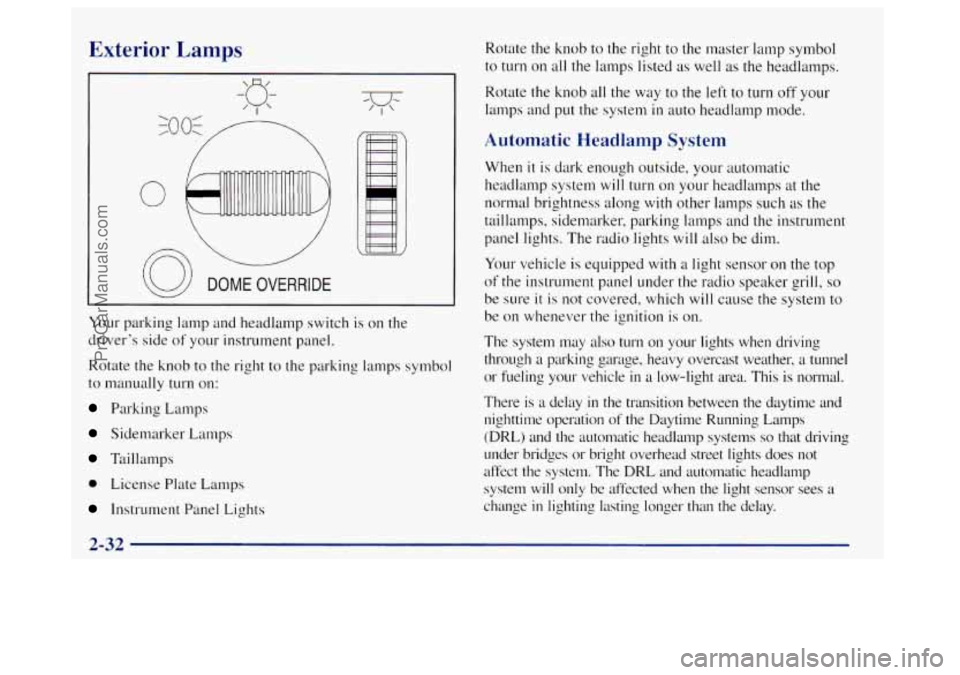
Exterior Lamps
Your parking lamp and headlamp switch is on the
driver’s side
of your instrument panel.
Rotate the knob to the right to the parking lamps symbol
to manually turn on:
Parking Lamps
Sidemarker Lamps
Tidillamps
0 License Plate Lamps
Instrument .Panel Lights Rotate
the knob
to the right to the master lamp symbol
to turn on all the lamps listed as well as the headlamps.
Rotate the knob all the way to the left to turn
off your
lamps and put the system
in auto headlamp mode.
Automatic Headlamp System
When it is dark enough outside, your automatic
headlamp system will turn on your headlamps at the
normal brightness along
with other lamps such as the
taillamps, sidemarker, parking lamps and the instrument
panel lights. The radio lights
will also be dim.
Your vehicle is equipped with a light sensor
on the top
of the instrument panel under the radio speaker grill, so
be sure it is not covered, which will cause the system to
be on whenever the ignition
is on.
The system may also turn on your lights when driving
through a parking gzage, heavy overcast weather, a tunnel
or fueling your vehicle in a low-light area. This is normal.
There is
a delay in the transition between the daytime and
nighttime operation
of the Daytime Running Lamps
(DRL) and the automatic headlamp systems
so that driving
under bridges or bright overhead street lights does not
afiect the system. The DRL and automatic headlamp
system
will only be affected when the light sensor sees a
change
in lighting lasting longer than the delay.
2-32
ProCarManuals.com